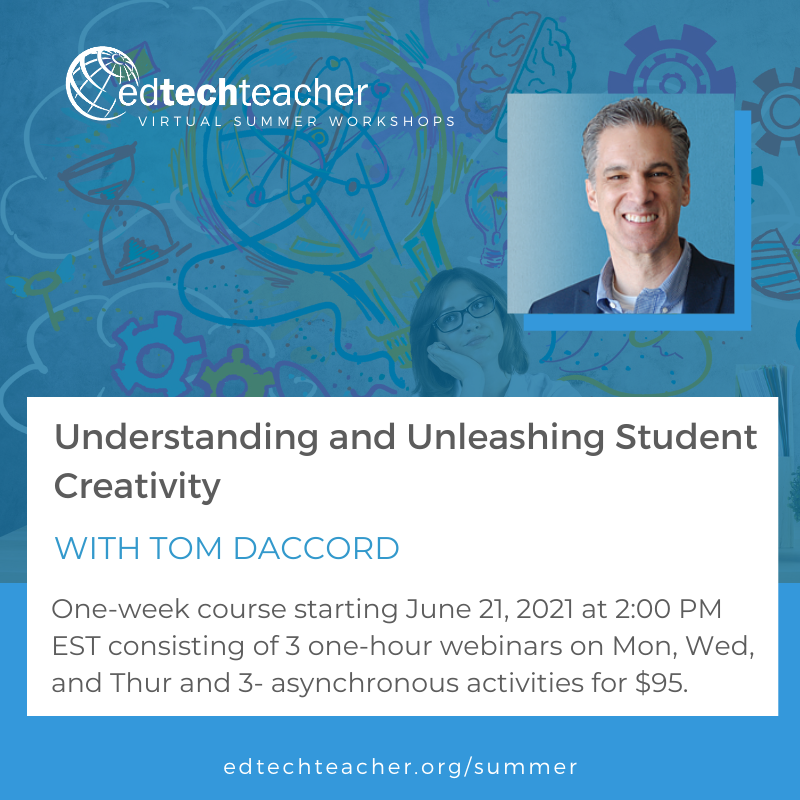This is the first of a two-part series.
Why student creativity?
To begin, let’s put student creativity in a societal context. For a long time now, we’ve witnessed machines replacing humans in performing routine physical and cognitive tasks, like those in assembly lines and basic office tasks. However, computers are becoming so sophisticated that they are learning to perform complex cognitive tasks.
These advances in “machine learning” have led the World Economic Forum to predict that by 2025, robots will handle 52 percent of current work tasks and that by next year, “even work tasks overwhelmingly performed by humans today — communicating, interacting, coordinating, managing and advising — will begin to be taken on by machines”. So, a challenge facing educators is to prepare students to thrive in an increasingly tech-infused work environment.
Fortunately, humans have a distinct advantage over computers. While computers excel in structured sequences that follow rules and models, we humans outperform machines at solving new problems. Computers have no imagination and are ill-equipped to solve abstract, unstructured cognitive challenges. We human beings are creative in the face of novel challenges and can innovate even in completely new environments.
So, student creativity is important beyond simply an opportunity for students to express themselves. “Being creative,” writes creativity expert Sir Ken Robinson, “is at the heart of being human and of all cultural progress.” Robinson emphasizes that it’s our capacity to be creative that is required to address today’s complex issues. Author Marcus Du Sautoy of The Creativity Code adds that because machines lack consciousness computers can never be more than a tool for extending human creativity. DuSautoy urges us to leverage our creativity to make the most out of data-based machines and further human progress.
So, as we think about nurturing student creativity, we need to keep in mind that humans possess more cognitive flexibility and adaptability than rules-based computers, and our teaching should strive to hone and express that creativity. Student creativity is not only about self-expression; it’s a critical educational objective.
What is student creativity?
In Developing Student Creativity, authors Kettler, Lamb, and Mullet point out that creativity has three defining characteristics: originality, usefulness, and appropriateness. In short, creativity is the generation of high-quality ideas or products that are novel, useful, and appropriate within the context of a task.
An original idea or product is a novel one, but it does not have to be completely new. In other words, creativity can manifest itself simply by changing one’s approach to a problem or issue. So, originality can include new perspectives or new interpretations on an existing topic or phenomenon.
But, novelty is not enough. In an educational environment, students must generate creative ideas or products that fall within the curricular scope of what is useful and appropriate. In other words, student creativity must be helpful and relevant in addressing the academic topic at hand. Creative ideas should add value to a specific academic pursuit.
Here are a few examples of creative student responses via Developing Student Creativity:
- Students generate ideas in response to a prompt or challenge.
- Students develop new ideas that represent modifications to existing ideas.
- Students develop new ideas that are radical departures from existing ideas.
- Students create original works as forms of personal or small group expression.
- Students develop, implement, and communicate new ideas, interpretations and problem-solving models effectively.
- Students identify trends and forecast possibilities.
Note that creativity involves cognitive processes and often creative products. To be creative, students must think critically about a topic. They must analyze and evaluate ideas for usefulness and appropriateness. They must apply existing knowledge in a new way. Often, students create original works, or products, as a result of these cognitive processes. They might create a model, a simulation, or an artistic interpretation.
Student creativity is often revealed when students address problems that have no clear path to a solution. As they wrestle with the ambiguity and incompleteness inherent in a challenging problem, students will often innovate, a manifestation of creativity. In other words, students might develop a new method or product that adds value in an academic realm. So, often when we witness student creativity we see signs of innovation.
But not all creativity is problem solving. As Du Sautoy points out, creating art is not a problem-solving activity. We humans have the urge to sing a song or draw a picture, but a “soulless” computer lacks that aspect of humanity.
In sum, creativity can manifest itself in different ways. And an art teacher might view creativity differently than a science teacher. So, how might we nurture subject-specific student creativity? And how might we assess student creativity? Those questions will be addressed in the second part of this series.
If you are interested in exploring student creativity in greater detail with Tom, consider joining him for a 1 week virtual summer workshop. Learn more about the workshop & all of our virtual summer workshop sessions.


